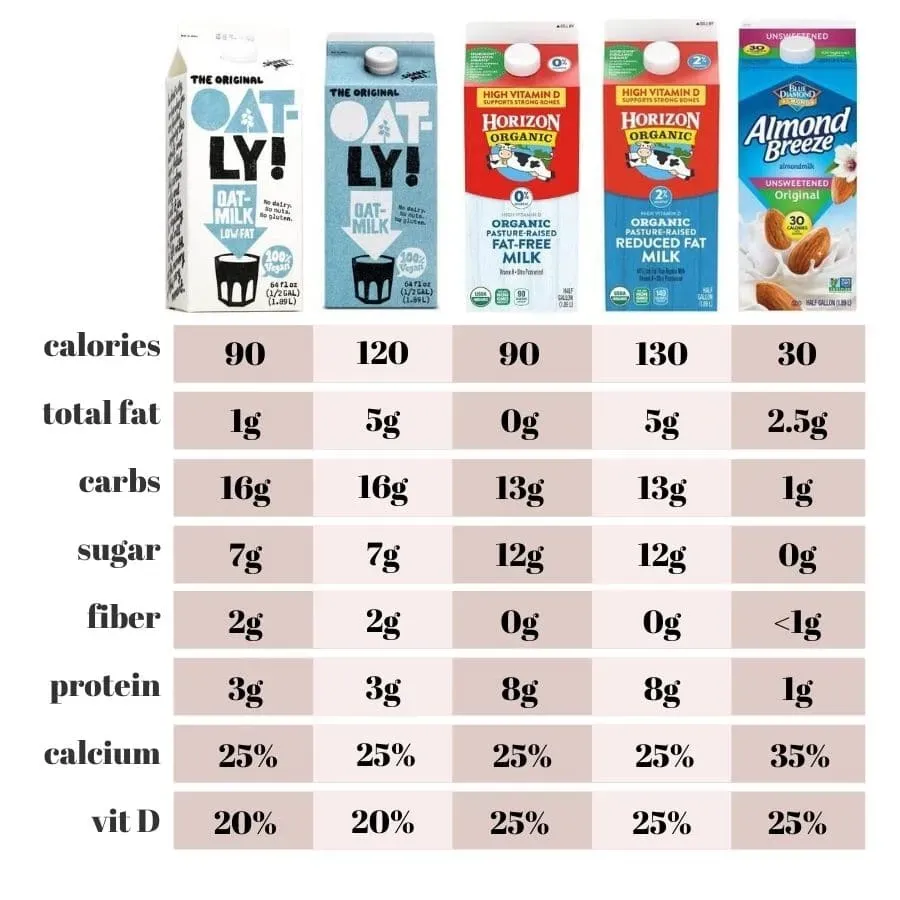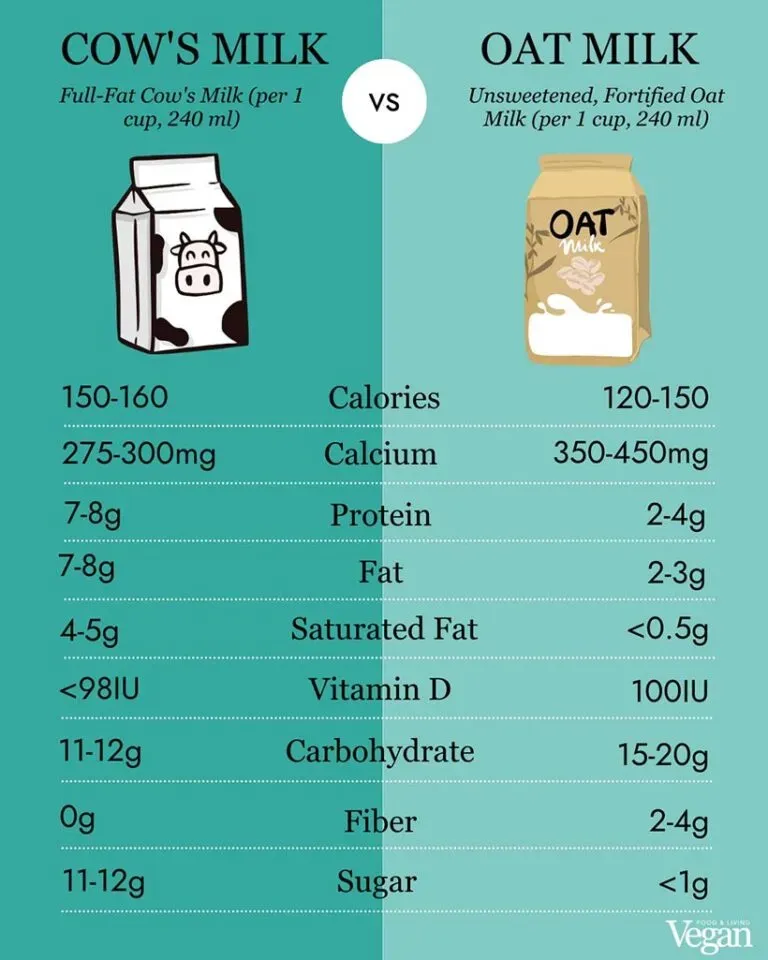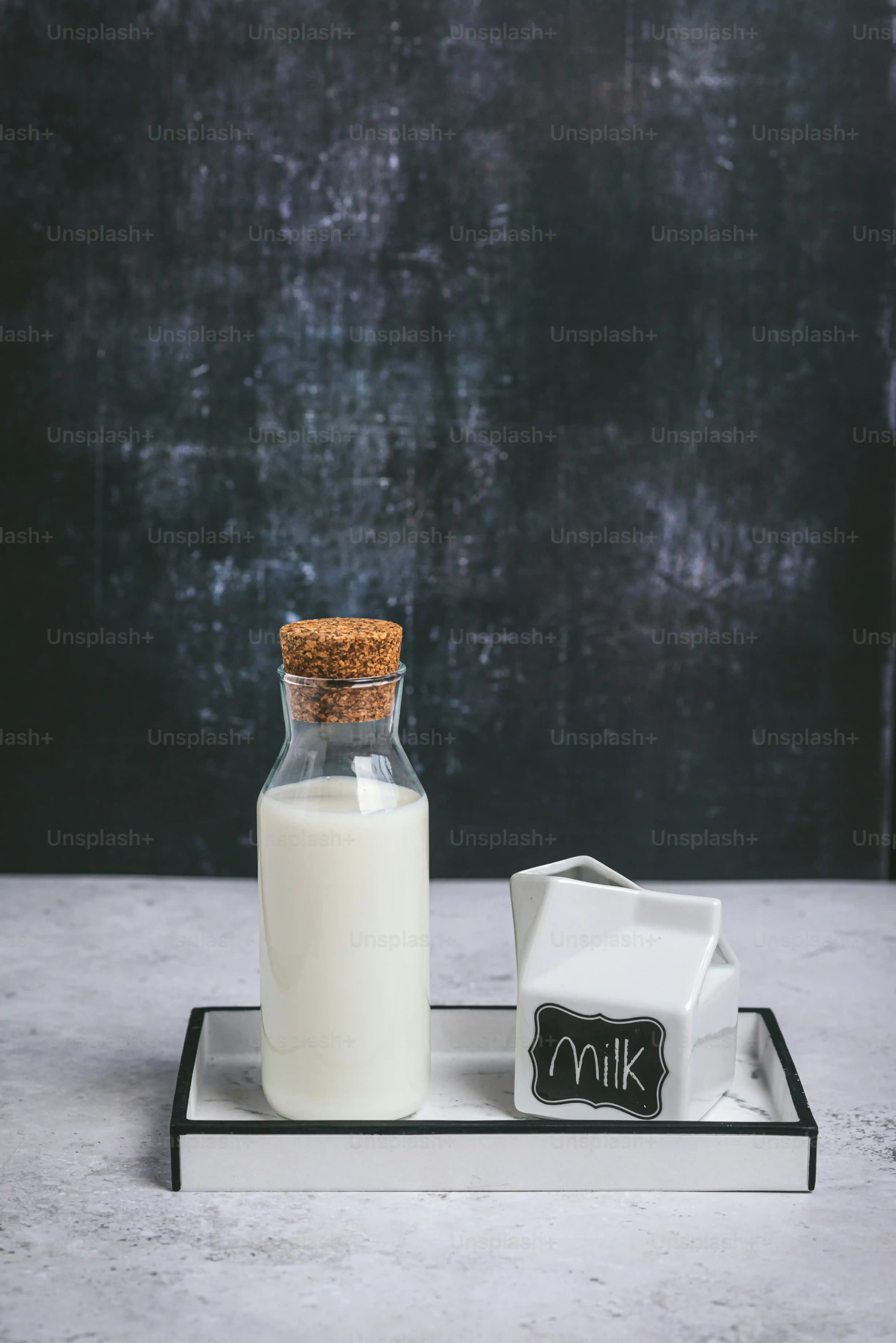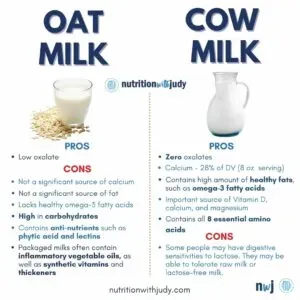Table of Contents
Walk into any grocery store today, and the dairy aisle isn't just about dairy anymore. It's a crowded scene, with cartons of plant-based alternatives vying for shelf space alongside the familiar jugs of cow's milk. Among the most popular contenders is oat milk, often presented as a healthier, trendier choice. But how does it really stack up against the old standby, specifically low fat milk? Is that creamy latte add-in giving you what you think it is, or are you better off sticking to the stuff that comes from a cow?
Nutritional Showdown: Oat Milk vs Low Fat Milk

Nutritional Showdown: Oat Milk vs Low Fat Milk
Protein Power Play
Let's get straight to it. When you're looking at oat milk vs low fat milk, one of the biggest nutritional differences stares you right in the face: protein. A standard 8-ounce glass of low fat dairy milk packs a solid 8 grams of protein. That's the kind of protein your body actually uses pretty efficiently. Now, look at most oat milk cartons. You'll typically find around 2 to 3 grams of protein per serving. See the gap? If you're relying on your morning beverage to contribute significantly to your protein intake, low fat milk wins this round hands down. It's not even a close fight.
Vitamins, Minerals, and Fortification Games
Beyond protein, dairy milk naturally contains a whole lineup of essential nutrients – we're talking 13 different ones, including calcium, vitamin D (often added, but present in the base), potassium, and B vitamins. It's a nutrient-dense package nature put together. Oat milk, on the other hand, starts its life primarily as oats and water. The vitamins and minerals you see listed on the carton? Most of those are added during processing. They fortify it to try and mimic dairy's profile, but it's not the same as getting nutrients from a whole, unprocessed food. The amount and type of fortification can also vary wildly between brands, so you really have to read the fine print.
Nutrient (per 8 oz) | Low Fat Milk | Typical Fortified Oat Milk |
|---|---|---|
Calories | 100-120 | 120-130 |
Protein | 8g | 2-3g |
Fat | 2.5g | 2-2.5g |
Carbohydrates | 12g (lactose) | 16-17g (from oats, often added sugar) |
Calcium | ~30% DV | ~35% DV (fortified) |
Vitamin D | ~25% DV (fortified) | ~25% DV (fortified) |
Carbs, Sugar, and the Glycemic Hit
Here's another point of divergence. Low fat milk contains lactose, a naturally occurring sugar, contributing around 12 grams of carbohydrates per serving. Oat milk, derived from grains, is naturally higher in carbs. You'll often see 16 grams or more per cup. What's more concerning is the added sugar. While plain low fat milk has no added sugar, many oat milk varieties include sweeteners to improve taste and texture. This jacks up the calorie count and gives you a quicker blood sugar spike compared to the natural sugars in dairy. Always check the "Added Sugars" line on the nutrition label – it can be surprising how much is in there.
Beyond the Basics: Ingredients and Fortification

Beyond the Basics: Ingredients and Fortification
What's Actually In Your Glass? Dairy Milk's Simple List
Look at a carton of low fat milk. What do you see on the ingredient list? Usually, just one thing: milk. Sometimes it's standardized to 1% or 2% fat, and often it's fortified with Vitamin D, which helps your body absorb calcium better. That's pretty much it. It's a minimally processed food, essentially packaged as it comes from the source (after pasteurization and homogenization, which are standard food safety practices). When you're comparing oat milk vs low fat milk based on ingredient simplicity, dairy milk takes the prize for being straightforward and, well, just milk.
Oat Milk's Cast of Characters: Thickeners, Stabilizers, and More
Now, pick up a carton of oat milk. The ingredient list tells a different story. You'll find water and oats, sure, but then things get interesting. To give it that creamy texture people like in coffee or cereal, manufacturers often add oils (like rapeseed or sunflower oil), gums (like gellan gum or guar gum), emulsifiers, and acidity regulators. These aren't necessarily *bad* ingredients, but they're processed additives designed to create a mouthfeel that doesn't naturally occur when you blend oats and water. Plus, as we touched on earlier, there's the fortification – adding back vitamins and minerals that aren't inherent to the base product, which can vary significantly from one brand to the next in the great oat milk vs low fat milk debate.
Common Oat Milk Additives You Might See:
- Vegetable Oil (Rapeseed, Sunflower)
- Dipotassium Phosphate (Acidity Regulator)
- Calcium Carbonate (Fortification)
- Gellan Gum (Stabilizer)
- Natural Flavors
- Salt
- Vitamins (D2, Riboflavin, B12)
- Minerals (Calcium, Iron)
Health Impacts: Is Oat Milk or Low Fat Milk Better For You?

Health Impacts: Is Oat Milk or Low Fat Milk Better For You?
Bone Health: Calcium, Vitamin D, and the Absorption Question
When people think of milk, they often think of strong bones, and for good reason. Dairy milk is a natural source of calcium, and it's almost always fortified with vitamin D, a dynamic duo crucial for bone density. Your body actually absorbs the calcium in dairy milk pretty well. Now, with oat milk vs low fat milk in the bone health arena, oat milk usually *is* fortified with calcium and vitamin D to levels comparable to dairy. That sounds good on paper, right? But here's the catch: the *type* of calcium and vitamin D used for fortification, and the presence of other compounds in oat milk (like phytic acid), might affect how well your body can actually use those added nutrients compared to the naturally occurring ones in dairy. It's like being given the ingredients versus having the finished meal ready to eat.
Heart Health: Fat Types and Added Oils
Looking at fat content in the oat milk vs low fat milk comparison, low fat milk, by definition, has less fat than whole milk, primarily saturated fat. Dietary guidelines have historically wagged a finger at saturated fat, though the science is getting more nuanced. Oat milk, while often low in saturated fat, usually contains added vegetable oils like rapeseed or sunflower oil. These are typically unsaturated fats, often touted as "heart-healthy." However, the processing required to emulsify these oils into the oat base is a factor, and you're consuming added fats that aren't naturally part of the oat itself. It's not as simple as low fat equals better; you need to consider the *type* of fat and whether it's naturally present or added during manufacturing.
Quick Look at Potential Health Considerations:
- Dairy Milk: Natural nutrients, potential for lactose intolerance, some saturated fat (in non-skim).
- Oat Milk: Fortified nutrients (absorption varies), added oils and sugars common, lower protein.
So, which is "better" for your health? It depends heavily on your individual needs, dietary patterns, and what specific product you choose. Are you getting calcium and vitamin D elsewhere? Do you have lactose issues? Are you watching added sugars? These questions matter more than just picking the trendiest carton.
Blood Sugar Response: Carbs, Sugar, and the Glycemic Index
Consider how these drinks affect your blood sugar. Dairy milk contains lactose, which is digested relatively slowly. Oat milk, being derived from a grain, is higher in carbohydrates. These carbs are often broken down more quickly by your body, potentially leading to a faster rise in blood sugar levels, especially if the oat milk contains added sugars. Some sources suggest oat milk has a higher glycemic index than dairy milk, meaning it can cause a more rapid blood sugar spike. If you're managing blood sugar, or just trying to avoid energy crashes, this is a significant point in the oat milk vs low fat milk discussion. That quick hit of sweetness or creaminess might come with a less-than-ideal metabolic response for some people.
Cost, Carbs, and Coffee: Practical Considerations

Cost, Carbs, and Coffee: Practical Considerations
The Price Tag: What Your Wallet Says About Oat Milk vs Low Fat Milk
Alright, let's talk money. Because let's be honest, that factors into the oat milk vs low fat milk decision for most people. Wander down the milk aisle, price tags are right there staring at you. Generally speaking, low fat dairy milk is the more budget-friendly option. It's a staple, produced at scale, and has been around forever. Oat milk, and most other plant-based alternatives, usually carries a premium price tag. You're often paying for the processing, the marketing, and frankly, the trendiness. If you're buying a gallon or two a week, that price difference adds up over time. Don't just grab the pretty carton without glancing at the cost per ounce.
Milk Type | Typical Price Range (per gallon/half gallon) |
|---|---|
Low Fat Milk | $3 - $4 per gallon |
Oat Milk | $4 - $6 per half gallon (effectively $8 - $12 per gallon equivalent) |
Carbs Beyond Blood Sugar: Energy and Dietary Context
We touched on carbs and blood sugar spikes earlier, but let's think about total carbohydrate intake. If you're following a lower-carb diet for whatever reason – maybe managing weight, maybe just how you feel best – the carb count in your beverage matters. Low fat milk has about 12 grams per cup, mostly lactose. Oat milk typically clocks in at 16 grams or more, often with added sugars boosting that number. If you're pouring a couple of cups a day, that's an extra 8-10 grams of carbs just from your drink compared to dairy. It's not a dealbreaker for everyone, but it's a detail worth noting, especially if you're counting macros or trying to limit refined carbs and added sugars in your overall diet when weighing oat milk vs low fat milk.
Barista Skills (or Lack Thereof): Performance in Hot Drinks
the coffee test. This is where many people make their choice. Oat milk gained popularity partly because it steams and froths reasonably well for lattes and cappuccinos, often better than almond or soy milk. It has a natural creaminess that dairy milk also provides. However, not all oat milk is created equal in this regard; some curdle in hot coffee, especially if the coffee is acidic. "Barista blends" of oat milk contain even more added oils and stabilizers specifically to prevent this and create a better foam, further complicating the ingredient list. Low fat dairy milk steams reliably and provides that classic microfoam texture. If your daily ritual involves a carefully crafted hot beverage, testing how your chosen milk behaves is non-negotiable.
Things to Consider for Coffee/Tea:
- Does it curdle in hot beverages?
- How well does it steam/froth?
- Does its flavor overpower the coffee/tea?
- Is it a "barista blend" with extra additives?
Making Your Choice: Summing Up Oat Milk vs Low Fat Milk

Making Your Choice: Summing Up Oat Milk vs Low Fat Milk
Weighing the Nutritional Trade-offs
Alright, so we've laid out the facts. When you line up oat milk vs low fat milk, the nutritional score isn't tied. Low fat dairy milk brings a naturally complete protein package – 8 grams per cup – along with 13 essential nutrients the cow put there herself. You get calcium, potassium, B vitamins, the works, usually with added Vitamin D for good measure. Oat milk, while fortified to look similar on paper for some nutrients like calcium and Vitamin D, starts with significantly less protein (think 2-3 grams) and is naturally higher in carbohydrates. Plus, its vitamins and minerals are added in, and how well your body uses them compared to dairy's natural ones is still a bit of a question mark for some folks.
Consider what you need from your drink. Is it a protein boost? Dairy milk wins. Are you avoiding lactose? Then oat milk, or a lactose-free dairy milk, enters the picture. Are you watching your sugar intake? Plain low fat milk has natural sugar (lactose), but many oat milks sneak in added sugars, which can mess with your blood sugar more abruptly than dairy's slower-digesting lactose.
Beyond the Carton: Ingredients, Cost, and Coffee Performance
Peel back the label, and the ingredient lists tell another tale in the oat milk vs low fat milk saga. Dairy milk is usually just milk, maybe with Vitamin D. Simple. Oat milk? It's oats and water plus a chorus line of added oils, gums, and stabilizers to give it body and make it play nice in your coffee. These additives aren't necessarily harmful, but they turn a simple grain-and-water blend into a processed product. Price-wise, dairy milk generally costs less. It's the mass-produced staple. Oat milk tends to be pricier, reflecting its processing and maybe a bit of that "trendy" tax.
And yes, how it behaves in your coffee matters. Oat milk gets points for frothing better than some other plant milks, but you often need a "barista blend" loaded with extra fat and emulsifiers to avoid curdling. Low fat dairy milk is a reliable workhorse for steaming. So, think about what you're actually doing with the stuff once you get it home.
Quick Comparison Points:
- Simplicity: Dairy milk has fewer ingredients.
- Cost: Low fat milk is typically cheaper.
- Coffee: Both can work, but oat milk often needs additives for best results.
- Processing: Oat milk involves more steps and added ingredients.
Making Your Informed Decision
So, where does that leave you in the great oat milk vs low fat milk debate? There's no universal "better" here. It truly hinges on your personal dietary needs, preferences, and priorities. If you value high protein, a comprehensive natural nutrient profile, simplicity, and a lower price point, low fat dairy milk holds a strong position. If you need to avoid lactose, prefer a plant-based option despite the lower protein and added ingredients, or specifically like oat milk's taste and coffee performance (and don't mind paying more for a barista blend), then oat milk might be your pick.
Just don't swap one for the other assuming they're nutritionally equal. They aren't. Read the labels, understand what you're getting (or not getting), and pick the milk that actually supports your health goals and fits your budget, rather than just following the crowd or the latest social media trend. The choice isn't about which milk is inherently "good" or "bad," but which one is the right fit for *you*.
Making Your Choice: Summing Up the Oat Milk vs Low Fat Milk Debate
So, after sifting through the nutritional facts, the ingredient lists, and the health considerations, where does that leave you in the oat milk vs low fat milk discussion? The reality is, there's no single "best" milk for everyone. Low fat dairy milk consistently offers a more robust package of naturally occurring essential nutrients, significantly higher protein, and a simpler ingredient list, often at a lower price point. It has a track record backed by research regarding its potential health benefits. Oat milk, while a popular plant-based alternative that works for those avoiding dairy, often requires fortification to match even some of dairy's basic nutrients, typically contains more carbs and sometimes added sugars, and its nutritional profile can vary wildly between brands. Your decision ultimately hinges on your specific dietary needs, preferences, and priorities – whether that's maximizing natural nutrients, managing specific intolerances, or simply enjoying the taste in your coffee.
